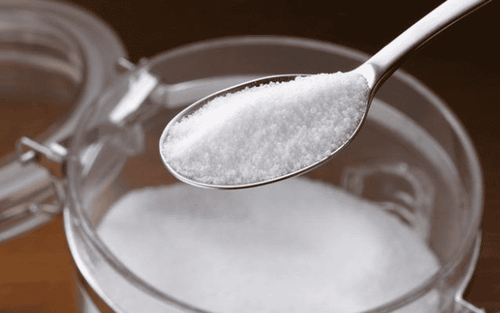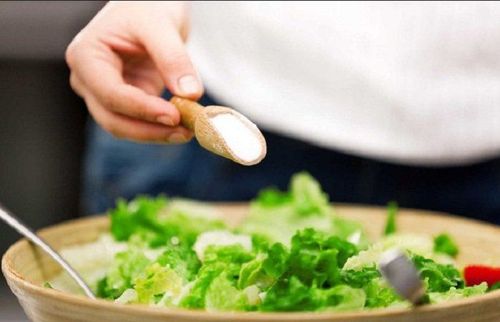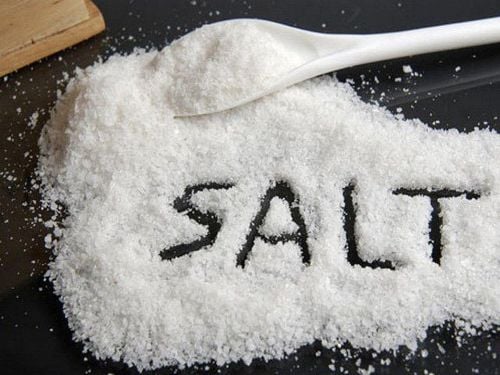This is an automatically translated article.
The article is professionally consulted by Master, Doctor Nguyen Thi Nhat - Infectious Diseases - Department of Medical Examination & Internal Medicine - Vinmec Hai Phong International General HospitalSodium in salt is an essential substance in the body's vital activities, but too much salt is harmful to the body. According to WHO statistics, Vietnamese people are eating twice the recommended amount of salt, which increases diseases, especially blood pressure and heart disease.
1. How much salt should you eat each day?
Salt contains sodium - an essential substance for the body's vital activities. It helps to ensure proper nerve transmission, muscle contractions, and other body functions can take place. Salt is normally eliminated from the body through sweat and urination, and is brought into the body from the salt found in the foods we eat.
WHO recommends, each person should only use 5g of salt / person / day, equivalent to about a teaspoon of salt.
For the body's required sodium intake, the World Health Organization (WHO) recommends consuming less than 2 grams of sodium per day. The American Heart Association also recommends a more cautious intake of no more than 1.5 grams of sodium per day, especially for people at risk for cardiovascular disease.
The World Health Organization also recommends that limiting salt intake helps people with hypertension to better control blood pressure. Specifically: only 2.3 grams of salt per person per day (one teaspoon of salt) will help reduce blood pressure by 2-8 mmHg.
Limiting salt is especially necessary for people with high blood pressure, people with heart failure or the elderly. You'll be able to tell if you have too much salt when you have symptoms like bloating and water retention. The brain also receives signals that the body needs more water. This will cause you to experience extreme thirst to make you drink more water.
Trắc nghiệm: Muối trong thực phẩm, natri, huyết áp và sức khỏe của bạn
Muối, natri là chất khoáng cần thiết cho cơ thể để duy trì hoạt động ổn định. Tuy nhiên, chế độ ăn thừa muối có nguy cơ cao dẫn tới các vấn đề sức khỏe nghiêm trọng. Cùng làm bài trắc nghiệm sau đây để hiểu hơn về những ảnh hưởng của các khoáng chất này tới huyết áp và sức khỏe bạn thế nào nhé.
Nguồn tham khảo: webmd.com
2. Vietnamese people are eating more than the allowed amount of salt
According to Mr. Kidong Park, Chief Representative of the World Health Organization (WHO) in Vietnam, the whole world is eating salty food. The average amount of salt used is 10 grams/person/day, twice the WHO recommendation.
Vietnamese people too, each Vietnamese is eating about 10g of salt a day and eating salty is increasing many diseases, the most significant of which is cardiovascular disease and hypertension.
In many developed countries, up to 75% of daily salt intake comes from processed foods, fast food, and restaurant food. In Vietnam, up to 70% of salt used is from home-cooked food, the remaining 30% is fast food and restaurant food. Thus, the reason for consuming twice the amount of salt allowed is mainly because Vietnamese people have a habit of eating salty and salty cooking.
Vietnam's goal is to reduce the average table salt by 30% by 2025, ie to 7 grams/person/day, by 2030, it is ideal to further reduce it to 5 grams/person/day.

3. How to reduce the amount of salt consumed each day?
Experts of the National Institute of Nutrition guide the principles of reducing daily salt intake: Reduce salt when seasoning, cooking, when dipping, be gentle.
WHO recommends that people use 5g of salt/person/day for better health, so 5g of salt is equivalent to 2 tablespoons of salted yogurt/person/day. However, Vietnamese people have a tradition of using fish sauce and soy sauce for dipping, even seasoning and seasoning food.
The ingredient to reduce in table salt is sodium. This ingredient is also included in spices for seasoning and dipping. If dipping fish sauce, soy sauce, or marinating food, you need to reduce the amount of salt to 1/2, which is only about 1 teaspoon of salted yogurt/person/day.
When converting, the National Institute of Nutrition guides 5g of salt equivalent to 35 grams of soy sauce (7 teaspoons); equivalent to 8 grams of soup powder (more than 1.5 teaspoons), 11 grams of seasoning seeds (more than 2 teaspoons of seasoning seeds) and 26 grams of fish sauce (equivalent to more than 5 tablespoons of fish sauce).
Measures to reduce salt intake:
Increase intake of fresh foods Regularly eat boiled dishes Limit the consumption of processed foods, which contain a lot of salt such as instant noodles, spring rolls, vegetables, salt, and chips Bim... Reduce braised, rimmed, roasted and pickled dishes , water of vermicelli, pho, vermicelli, especially when eating at restaurants When cooking, if you can combine spices such as pepper, chili, lemon... the dish will be more delicious without having to use a lot of salt . To avoid the use of foods with a lot of salt, people need to pay attention to check the amount of salt listed on food packaging for ready-to-eat foods, limit eating foods that use a lot of salt such as pickles, braised dishes, and cooking. Use less salt to replace the salty taste of salt.
Follow a diet with an adequate amount of salt every day to help you protect your own and family's heart health simply and effectively.














